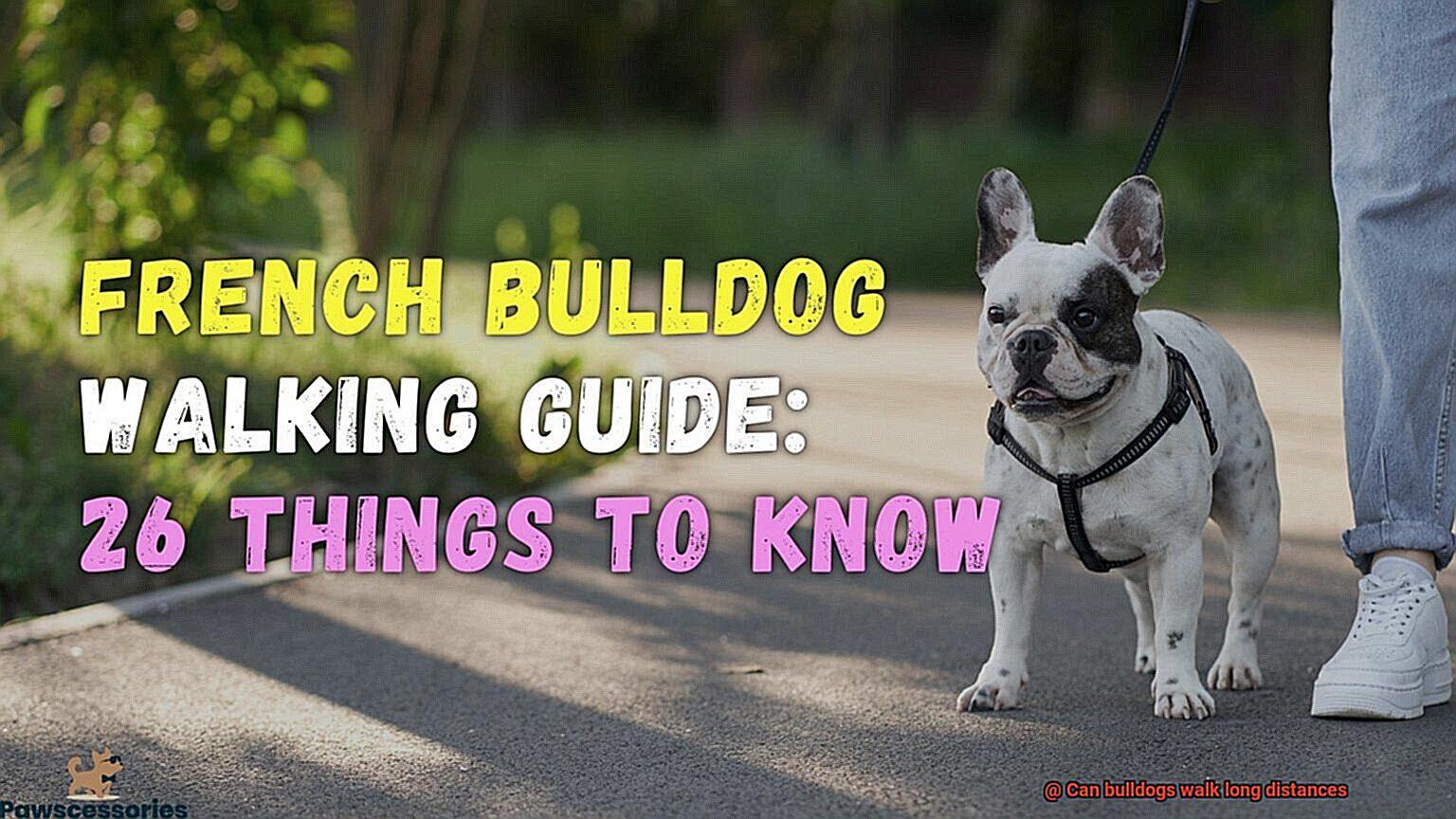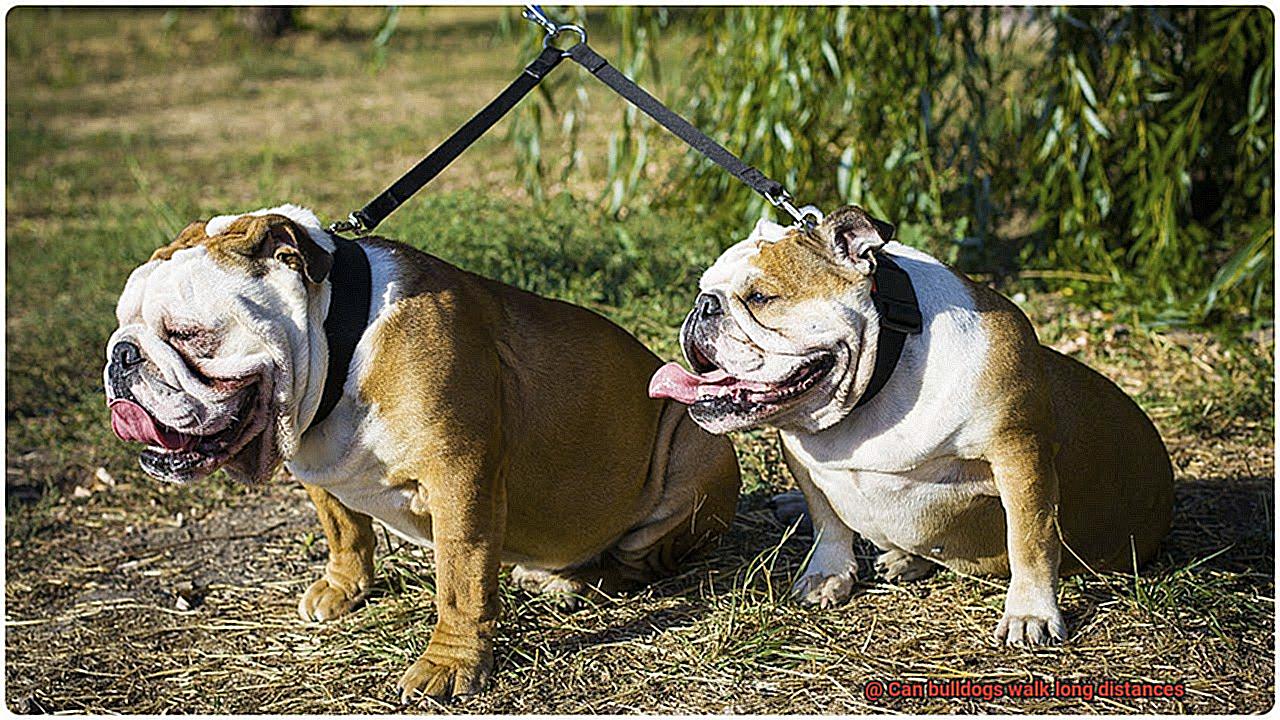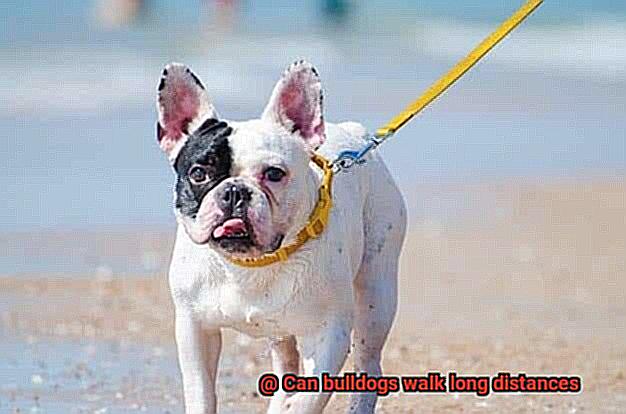Can bulldogs walk long distances?
Today, we’re diving deep into the world of bulldogs and their walking prowess. We all know these wrinkly-faced cuties for their snorts and squishy faces, but what about their endurance?
As a self-proclaimed bulldog aficionado, I’m here to spill the beans on their physical abilities and give you the lowdown on everything you need to know. So grab that leash, tighten it up, and get ready to join me on this exciting adventure as we uncover just how far bulldogs can strut their stuff.
The Physical Limitations of Bulldogs for Long-Distance Walks
Contents
- 1 The Physical Limitations of Bulldogs for Long-Distance Walks
- 2 Understanding Bulldog Health and Safety Concerns
- 3 Tips for Taking Your Bulldog on a Long Walk
- 4 Preparing for a Long Walk With Your Bulldog
- 5 How To Recognize Signs of Fatigue in Bulldogs
- 6 Knowing When It’s Time to Stop the Walk
- 7 Alternatives for Exercise With Your Bulldog
- 8 Conclusion
Bulldogs are beloved for their adorable wrinkled faces and stocky bodies. However, these physical characteristics can pose challenges when it comes to long-distance walks. In this article, we will explore the physical limitations of bulldogs, particularly French Bulldogs, and why it’s important to prioritize their health and well-being during exercise.
Brachycephalic Skull Structure:
Bulldogs have a brachycephalic skull structure, characterized by their shortened snouts. This can lead to respiratory issues, making it difficult for them to engage in strenuous activities like long-distance walks. Their compromised ability to regulate body temperature due to shortened airways puts them at a higher risk of heatstroke, especially in hot and humid weather conditions.
Low Tolerance for Exercise:
Despite their muscular build, bulldogs have a relatively low tolerance for exercise compared to other breeds. They tire easily and may struggle with extended physical exertion. Obesity is also a common concern, so it’s important to manage their weight and engage in low-impact activities suitable for their breed characteristics.
Joint Issues:
Bulldogs are prone to joint issues such as hip dysplasia and patellar luxation. These conditions can cause pain and discomfort during long walks, making it crucial to consider the impact on their overall health. Opting for low-impact activities that provide mental stimulation without excessive strain is recommended.
Cardiovascular Health:
Bulldogs are more susceptible to heart problems and spinal disorders. Prolonged exercise can strain their cardiovascular system, posing potential risks to their health. Consulting with a veterinarian before embarking on long-distance walks is essential to ensure they are physically capable and healthy enough for such activities.
Understanding Bulldog Health and Safety Concerns
French bulldogs, with their charming and distinct appearance, have captured the hearts of many dog lovers. However, it’s essential to understand that these adorable companions have unique health and safety concerns when it comes to walking long distances. Let’s explore these concerns in more detail:
Respiratory Difficulties:
French bulldogs, like other brachycephalic breeds, have flat faces and shorter snouts. This anatomical feature makes it harder for them to breathe efficiently, especially during physical exertion. When walking long distances, these dogs may struggle to take in enough air, leading to respiratory distress and overheating.
Heat Sensitivity:
Due to their compromised respiratory system, French bulldogs are more susceptible to heatstroke. Walking long distances in hot weather or humid conditions can put them at greater risk. It’s crucial to be mindful of the temperature and provide ample shade and water breaks to prevent overheating.
Joint Problems:
Bulldogs are prone to joint issues, such as hip dysplasia and arthritis. Walking long distances can strain their joints, leading to pain and discomfort. It’s important to be aware of their limitations and avoid excessive stress on their joints during walks.
Fatigue:
French bulldogs have a stocky build and shorter legs, which naturally make them slower than other breeds. Walking long distances can quickly exhaust them, causing fatigue and potential health issues. It’s crucial to monitor their energy levels and provide breaks as needed.
To ensure the health and safety of your French bulldog while walking long distances, here are some tips:
- Consult with your veterinarian: Before embarking on any strenuous activities, consult with your vet to assess your dog’s individual health condition and determine the appropriate level of exercise.
- Choose a suitable environment: Opt for walks in shaded areas to protect your dog from excessive heat. Avoid hot pavement or surfaces that can burn their sensitive paws.
- Watch for signs of exhaustion and overheating: Keep an eye out for excessive panting, drooling, or difficulty breathing. If your French bulldog shows any of these signs, take a break, find a cool spot, and provide water to prevent heatstroke.
- Consider low-impact exercises: Instead of long-distance walks, engage in activities that provide mental stimulation without excessive strain on their respiratory system and joints. This can include puzzle toys or short, leisurely walks.
Tips for Taking Your Bulldog on a Long Walk
Taking your bulldog on a long walk can be a fun and rewarding experience for both of you. Bulldogs may have unique physical characteristics that can make long walks more challenging, but with proper preparation and care, they can still enjoy the outdoors and get the exercise they need.
In this guide, we will explore some helpful tips to ensure a safe and enjoyable long walk with your bulldog.
Warm-up is Essential:
Just like humans, bulldogs need a warm-up before engaging in any physical activity. Start your walk with a slow-paced stroll for about 5 minutes to allow their muscles to warm up and get the blood flowing. This helps prevent strains or injuries and prepares them for the longer walk ahead.
Choose the Right Time and Place:
Bulldogs are sensitive to temperature extremes, so it’s important to choose the right time of day for their long walks. Early mornings or late evenings when the weather is cooler are ideal. Additionally, select a route that offers shade and avoid hot pavement or rough terrains that can be tough on their joints.
Harness Instead of Collar:
Bulldogs have a unique body shape with a thick neck, making using a collar uncomfortable and potentially harmful for them during walks. Opt for a well-fitted harness instead, which will distribute the pressure evenly across their chest and back, preventing any unnecessary strain on their neck.

Take Frequent Breaks:
Bulldogs are not known for their endurance, so it’s important to take frequent breaks during long walks. Plan for short rest periods every 10-15 minutes to allow them to catch their breath, hydrate, and cool down. This prevents them from overexerting themselves and becoming too tired or overheated.
Hydration is Key:
Bulldogs can easily overheat due to their short-nosed structure, so hydration is crucial during long walks. Always carry water and a collapsible bowl with you to provide regular drinks for your bulldog. Encourage them to drink at each break and monitor signs of dehydration such as excessive panting or lethargy.
Preparing for a Long Walk With Your Bulldog
Bulldogs may not be known for their endurance, but with the right preparation and care, they can certainly join you on a long walk. Here are some expert tips to ensure a safe and enjoyable experience for you and your four-legged friend.
- Check their health: Bulldogs are prone to certain health issues, such as respiratory problems and joint conditions. Before embarking on a long walk, it’s essential to have your bulldog undergo a thorough check-up with a veterinarian. This will help assess their overall fitness level and identify any potential issues that may arise during the walk.
- Condition gradually: Bulldogs may have a muscular build, but their physical characteristics can make intense physical activities challenging. Start by gradually increasing the duration and intensity of their walks over time. This will help build their stamina and strengthen their muscles, making them better prepared for a longer trek.
- Invest in proper gear: A well-fitted harness is recommended over a collar for better control and reduced strain on their necks. Consider purchasing comfortable walking shoes or boots to protect their paw pads from rough terrain or extreme weather conditions.
- Plan the route: Choose paths that offer shade, access to water sources, and minimal exposure to hot pavement or other surfaces that can potentially burn their paws. Be aware of any potential hazards along the way, such as steep inclines or rough terrain that may put excessive strain on your bulldog’s joints.
- Hydration is key: Bulldogs are prone to dehydration due to their inefficient cooling system. Carry plenty of fresh water for both you and your bulldog and offer regular water breaks throughout the walk. Watch out for signs of exhaustion or excessive panting, and allow them to rest and rehydrate as needed.
- Mind their pace: Bulldogs are not built for speed or endurance, so it’s important to walk at a comfortable and manageable pace for them. Pay attention to any signs of fatigue, such as heavy panting or slowing down. Be prepared to cut the walk short if necessary and prioritize your bulldog’s well-being.
How To Recognize Signs of Fatigue in Bulldogs
French Bulldogs are adorable and lovable companions, but their physical limitations require special attention during physical activities like walks. As a responsible owner, it’s essential to recognize the signs of fatigue in your French Bulldog to prevent overexertion and potential health issues. In this article, we will explore the key signs of fatigue in French Bulldogs and provide tips on how to keep them safe during exercise.
Excessive Panting:

One of the most obvious signs of fatigue in French Bulldogs is excessive panting. Due to their flat-faced features, French Bulldogs have a compromised respiratory system, making it harder for them to cool down efficiently. If you notice your furry friend panting heavily during a walk, it’s time to take a break and offer them some water to avoid overheating.
Slowing Down or Lagging Behind:
French Bulldogs are not known for their speed or endurance, but if your dog starts lagging behind more than usual or seems reluctant to continue walking, it may be a sign that they are tired and need a rest. Pay attention to their pace and allow them to take breaks when necessary.
Heavy Breathing or Wheezing:
If your French Bulldog starts struggling to catch their breath or making wheezing sounds while walking, it’s crucial to stop and let them rest. Pushing them further can lead to respiratory distress, which can be dangerous for their health.
Limping or Favoring One Leg:
Muscle soreness or fatigue can cause French Bulldogs to limp or favor one leg during walks. If you notice your dog showing signs of discomfort while walking, it’s best to give them a break and monitor their condition. Continuing the walk can potentially worsen the injury.
Excessive Drooling or Foaming at the Mouth:
French Bulldogs tend to drool more than other breeds, especially when they are tired. However, if your dog starts drooling excessively or foaming at the mouth during a walk, it may be a sign of overheating or exhaustion. Make sure to provide them with water and a shady spot to rest.
Knowing When It’s Time to Stop the Walk
French Bulldogs are known for their adorable looks and playful personalities. They love going on walks with their owners, exploring the world around them. However, it’s important to remember that French Bulldogs have certain physical limitations that require special attention during walks. As a responsible owner, it’s crucial to recognize the signs that indicate it’s time to stop the walk and give your furry friend a break.
- Excessive Panting: Bulldogs naturally pant to cool down, but if you notice that your French Bulldog’s panting becomes rapid and excessive, it could be a sign that they are struggling to breathe properly. This is especially true for French Bulldogs due to their short snouts and respiratory issues. When you see this, it’s time to find a shady spot and let your bulldog rest.
- Difficulty Breathing: Bulldogs have narrow airways, which makes it easier for them to become winded during exercise. If your French Bulldog starts wheezing, gasping for air, or making unusual noises while breathing, it’s a clear indication that they need to take a break. Stop the walk immediately and give them a chance to catch their breath.
- Overheating: Bulldogs are susceptible to overheating, especially in hot weather. Keep an eye out for excessive drooling, bright red gums, weakness, and disorientation. These are all signs of overheating, and it’s important to find shade or a cool area for your French Bulldog to rest and recover.
- Limping or Favoring a Leg: French Bulldogs are prone to joint issues and can easily strain or injure their legs during physical activities. If you notice your bulldog limping or showing signs of discomfort while walking, it’s best to end the walk and seek veterinary attention if necessary. Pushing them beyond their limits can worsen an injury or lead to further health complications.
- Energy Level: Pay attention to your French Bulldog’s overall energy level during the walk. If they start lagging behind, seem lethargic, or are reluctant to continue, it may be a sign that they are tired and in need of a break. It’s important to respect their limits and not push them beyond what they can handle.
- Hydration: Bulldogs can quickly become dehydrated during walks, especially in warm weather. Be sure to bring water for your French Bulldog and offer it to them regularly during the walk. If they refuse to drink or show signs of dehydration such as dry gums or sunken eyes, it’s time to end the walk and provide them with water and rest.
Alternatives for Exercise With Your Bulldog
French Bulldogs may have an irresistible urge to explore the world on walks, but it’s essential for responsible owners to recognize the signs that indicate when it’s time to hit the brakes and give their furry friends a much-needed break from panting like a marathon runner, gasping for air like a fish out of water, or overheating like a sizzling hot potato.
Additionally, keep an eye out for any limping or favoring of a leg, as well as their energy levels and hydration needs – after all, even these adorable bulldogs have their physical limitations.
Indoor Activities:
- Play Fetch: Set up a large, open space inside your home and engage in a fun game of fetch with your bulldog. This will not only provide them with physical exercise but also give you both some quality bonding time.
- Interactive Toys: Invest in interactive toys that require physical activity. These toys can keep your bulldog engaged and entertained while also giving them the exercise they need.
- Obstacle Courses: Create obstacle courses using furniture, cushions, and other household items. Bulldogs love a challenge, so set up a course that requires them to jump over obstacles or crawl through tunnels.
- Hide-and-Seek: Bulldogs have a great sense of smell, so playing hide-and-seek can be a stimulating and fun indoor activity. Hide treats or toys around the house and encourage your bulldog to find them.
Swimming:
Bulldogs and Water: Bulldogs are known to enjoy water, making swimming a great alternative for exercise. If you have access to a pool or a safe body of water, take your bulldog for regular swimming sessions. Swimming provides a low-impact workout that is gentle on their joints.
Dog Sports and Activities:
- Agility Training: Bulldogs may not be the first breed that comes to mind for agility training, but they can surprise you with their athleticism. Enroll your bulldog in agility classes or set up your own agility course at home.
- Obedience Classes: Obedience classes not only provide physical exercise but also mental stimulation for your bulldog. These classes can help improve their listening skills and overall behavior.
- Nose Work: Bulldogs have a fantastic sense of smell, so engaging them in nose work activities can be both physically and mentally stimulating. Hide treats or toys around the house and encourage your bulldog to find them using their nose.
Individualized Exercise:
- Pay Attention to Your Bulldog: Every bulldog is unique, so it’s important to pay attention to their individual abilities and limitations. Some bulldogs may be able to handle longer walks, while others may require shorter, more frequent exercise sessions.
- Consult with a Veterinarian: If you’re unsure about what types and amounts of exercise are suitable for your bulldog, consult with a veterinarian. They can provide valuable insight and guidance based on your bulldog’s specific needs.
iMpXeyX8VT4″ >
Conclusion
In conclusion, bulldogs are not typically well-suited for long-distance walks. Their unique physical characteristics, such as their short legs and brachycephalic (short-nosed) faces, can make it challenging for them to engage in prolonged exercise. While some bulldogs may have the stamina to walk longer distances, it is important to consider their individual health and fitness levels before embarking on such endeavors.
Bulldogs are known for their adorable and distinctive appearance, with their wrinkled faces and stocky bodies. However, these very traits that make them so endearing can also pose limitations when it comes to endurance activities like long walks. Their short legs may not be able to keep up with the pace required for extended periods of walking, and their brachycephalic nature can lead to respiratory issues during exertion.
That being said, every bulldog is unique and there may be exceptions to the general rule. Some bulldogs may have better stamina or higher fitness levels than others, allowing them to handle longer walks more comfortably. It is crucial, however, to consult with a veterinarian before embarking on any strenuous exercise routine with your bulldog.
When considering whether or not bulldogs can walk long distances, it is essential to prioritize their health and well-being above all else. Regular exercise is important for all dogs, including bulldogs, but it should be tailored to their individual needs and abilities. Shorter walks or moderate exercise sessions may be more suitable for most bulldogs, ensuring they stay happy and healthy without pushing them beyond their limits.
In conclusion, while some bulldogs may surprise you with their ability to tackle longer walks, it is generally best to keep their exercise routines shorter and more manageable. By understanding and respecting the limitations imposed by their physical characteristics, you can ensure that your beloved bulldog leads a fulfilling and comfortable life.




